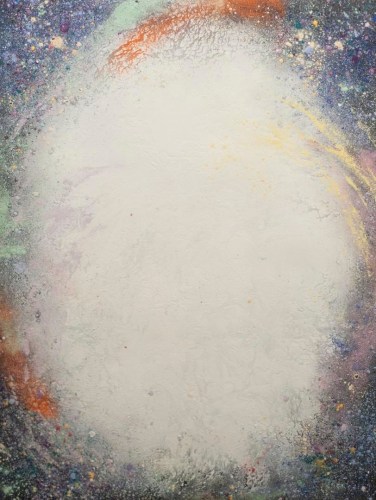
Mr. Bhavsar’s paintings can initially seem like simple renderings of feathery-edged geometric shapes — mostly squares within squares or rectangles. But patient viewing reveals a tremendous amount of detail and surface texture, achieved through the application of many layers of paint, sometimes as many as 80 or 90 in a single painting.
Like many of the Color Field painters, Mr. Bhavsar creates his paintings in a generally spontaneous, improvisational manner. He first soaks the canvas with acrylic-based binders that absorb and hold the fine pigment powder. Then he uses repeated applications of pigment to build up the surface while mixing them to allow subtle variations in color and tone.
Mr. Bhavsar applies the base using a sifting technique with a screen, during which layers of fine, concentrated pigment are sprinkled and drizzled over the canvas (or paper) laid out on the floor so that the artist can walk around the painting and work on it from all sides.
“K-Etu” (1974) by the Indian-born artist Natvar Bhavsar. CreditCollection of Diane and Steven Jacobson
This part of the painting is built up over weeks in a process of gradual accumulation, or sedimentation. Some paintings are left like this; on others, the artist spills pigment through a minute cone to create small linear and curvilinear forms, which together form the shape of a square in the middle of the image. Remarkably, neither technique involves the artist’s touching the canvas.
Mr. Bhavsar cannot claim originality for his methods. The techniques are derived in part from an Indian tradition of sand paintings made for religious rituals, and the materials that he uses are similar to the brightly colored pigments used during the springtime festival of Holi, when Indians come out on the streets and throw colored powders up in the air as part of the celebrations. They also sprinkle one another with colored powder.
Yet the absence of recognizable imagery in his work aligns Mr. Bhavsar more with American traditions of abstract art, and in particular Color Field painting; one is reminded variously of the work of the American painters Mark Rothko, Barnett Newman and Jules Olitski.
How, then, are we to read these abstract, hybrid artworks? To appreciate Mr. Bhavsar’s paintings you need to spend a long time looking at them. The more you look, the more you get out of them. You may also begin to realize that in some ways these paintings are all about looking, and the ability of areas of pure color to make a powerful, even emotionally resonant visual statement.
Of course, some of those statements are stronger and more captivating than others, though given the nature of these paintings I suspect that this is largely a matter of personal preference. My own taste runs to the grainy, heavily textured paintings with discrete variations in color and tone, like “Pralay” (1997), a huge, beautiful red work that looks like satellite imagery of the surface of Mars.
Mr. Bhavsar plays with scale, producing paintings that range in size from a square foot to more than 20 feet wide. The larger ones tend to have more of an impact, in part because they overwhelm you with their scale. But they also give you room to discover new areas of spatial and chromatic richness, prolonging the overall viewing experience. His best paintings engage and focus the eyes and mind so intensely that looking ultimately becomes an act of meditation.